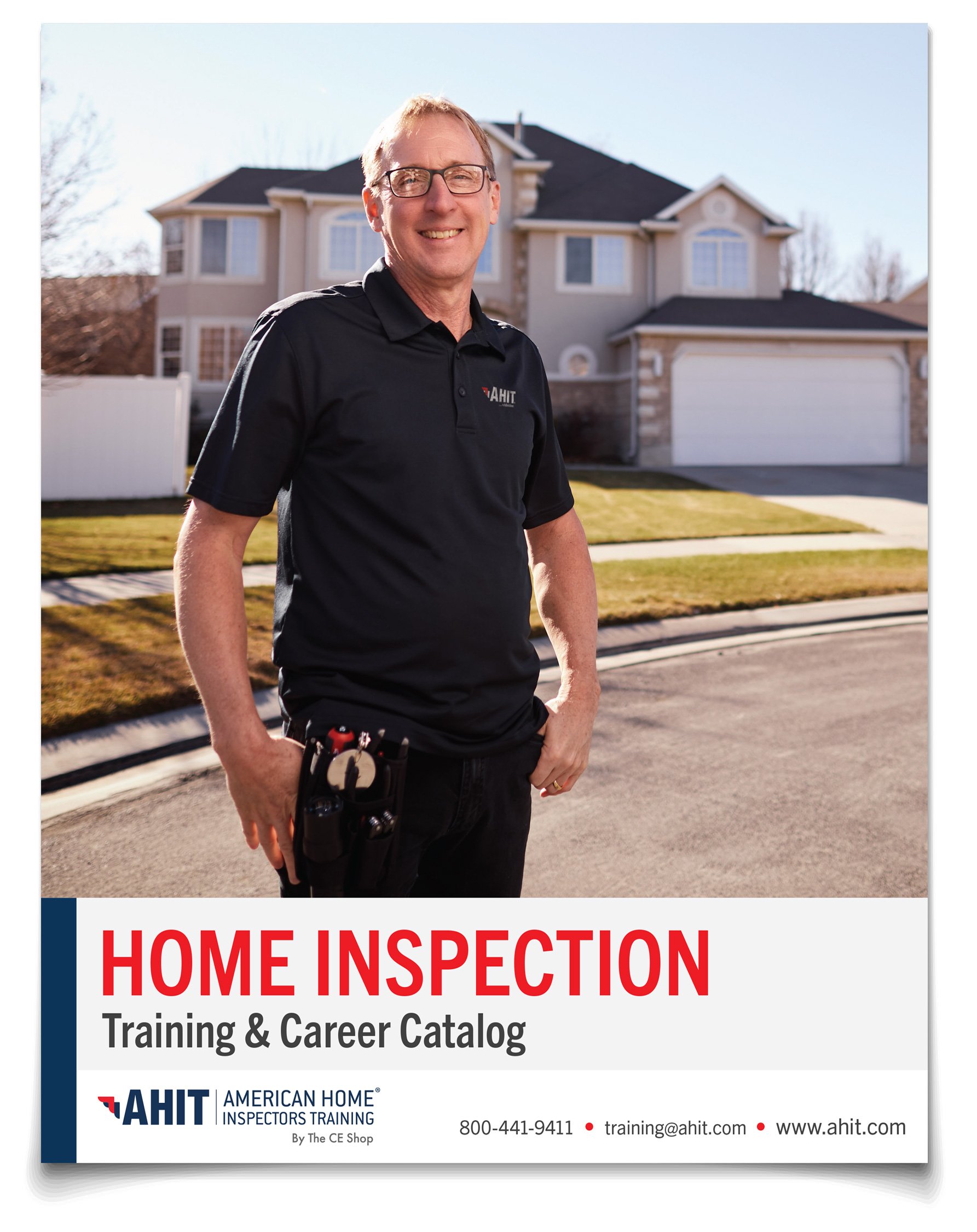Home Inspector Licensing and Certifications from AHIT
The AHIT Advantage for Home Inspection Licensing
Whether you’re looking to start a career in home inspection or a home inspector looking to add services and develop new skills, we’ve got you covered. Our live classroom training includes valuable hands-on field training and our online course options offer flexibility for your schedule. Each course is taught by successful home inspection entrepreneurs and provides in-depth training to help you establish and market your home inspection business.
AHIT Success Essentials included with ALL training options
Get more of what you need to succeed every step of the way with our AHIT Success Essentials!

Live & Online Courses Include:

Online Exercises, Practice Questions, and Exams: 14 study modules will help you learn the components of a home and provide the knowledge and skills necessary to perform a professional home inspection. Designed for a clear understanding to cement your learning.
Tutorials, practice questions, and interactivity will reinforce important concepts throughout the course and include real-life home inspection scenarios. The multiple-choice final exam is the last step and proof that you learned the skills to become a home inspector. AHIT’s course has a 99% exam pass success rate.
Exam Prep: Pass the first time with AHIT’s Exam Prep. Prepare for your Home Inspector exam with unlimited practice exams that give you hints and feedback to feel confident before taking your exam. Use practice mode to quickly learn concepts and test your knowledge with exam mode that provides you with questions like the real exam. This online smart study tool customizes topic areas for you that need more focus.

Standards of Practice (SOPSs): The SOPs used for AHIT’s courses are a hybrid of all the national as well as state-specific standards. These widely recognized professional guidelines identify what is to be inspected, what is not inspected, and what the report should include.
15 Bonus Courses: Robust business booster training to establish and market your business. More than 40 hours of extra marketing, business, and technical training courses are included for the most successful start. Choose either the Advanced or Expert Package and you’ll receive AHIT’s Marketing & Operating a Profitable Home Inspection Business eTextbook. This blueprint for a successful home inspection business includes your sales & marketing plan, inspection plan, office plan, and risk management.
Unlimited Instructor Support: You will have unlimited support from our home inspection industry experts with over 100 years of combined experience – even after you graduate. Ask them questions about the course, licensing, exam prep, in-field inspections, business tips, and more!
Home Inspection Reference Guide: Written by industry experts, A Practical Guide to Home Inspection, is AHIT’s #1 eTextbook and is a popular reference for both beginner and experienced home inspectors. The eTextbook includes expert tips and steps you through the inspection process with easy technical explanations and photos. Learn how to work with your customers and write up a real inspection report.
FREE Reporting Software: Get started off on the right foot with the necessary reporting tools to do your first inspections. Learn more than how to inspect the home. Get full access to superior report writing software used and recommended by AHIT instructors and graduates. Start with software that is top-rated by home inspectors for flexibility, ease of use, and is preferred by real estate agents.

Certificate of Completion: When you successfully complete the final exam in your course, you will receive your Certificate of Completion. This will allow you to use our AHIT Professional Inspector logo on all of your marketing materials, which signifies that you are part of an elite group of home inspectors. Congratulations – you are now an AHIT Graduate Home Inspector!
NHIE Exam Prep eTextbooks: Written by the creators of the National Home Inspectors Exam, these are two must-have exam prep books. Mechanical and Content Manual reviews topics such as electrical, cooling, heating, and plumbing. Structural and Business Manual reviews exam topics about roofing, ventilation, and more. Advanced or Expert Package Only!
Unlimited Customer Support: Access to AHIT’s customer support team for all student or technical questions. Extended hours include phone, email, and chat.

Errors & Omissions Insurance: AHIT students save up to $2,500 on annual Errors & Omissions insurance. Our unique partner specializes in home inspection liability. You will have access to coverage for ancillary services, resources for real-world benefits, risk management tools, and seminars.

How to Become a Home Inspector
FREE Webinar.
Register today.
- Alabama Home Inspector Training
- Alaska Home Inspector Training
- Arizona Home Inspector Training
- Arkansas Home Inspector Training
- California Home Inspector Training
- Colorado Home Inspector Training
- Connecticut Home Inspector Training
- Delaware Home Inspector Training
- Florida Home Inspector Training
- Georgia Home Inspector Training
- Hawaii Home Inspector Training
- Idaho Home Inspector Training
- Illinois Home Inspector Training
- Indiana Home Inspector Training
- Iowa Home Inspector Training
- Kansas Home Inspector Training
- Kentucky Home Inspector Training
- Louisiana Home Inspector Training
- Maine Home Inspector Training
- Maryland Home Inspector Training
- Massachusetts Home Inspector Training
- Michigan Home Inspector Training
- Minnesota Home Inspector Training
- Mississippi Home Inspector Training
- Missouri Home Inspector Training
- Montana Home Inspector Training
- Nebraska Home Inspector Training
- Nevada - Not Available
- New Hampshire Home Inspector Training
- New Jersey - Not Available
- New Mexico Home Inspector Training
- New York Home Inspector Training
- North Carolina Home Inspector Training
- North Dakota Home Inspector Training
- Ohio Home Inspector Training
- Oklahoma Home Inspector Training
- Oregon Home Inspector Training
- Pennsylvania Home Inspector Training
- Rhode Island Home Inspector Training
- South Carolina Home Inspector Training
- South Dakota Home Inspector Training
- Tennessee Home Inspector Training
- Texas Home Inspector Training
- Utah Home Inspector Training
- Vermont Home Inspector Training
- Virginia Home Inspector Training
- Washington Home Inspector Training
- Washington D.C. Home Inspector Training
- West Virginia Home Inspector Training
- Wisconsin Home Inspector Training
- Wyoming Home Inspector Training
